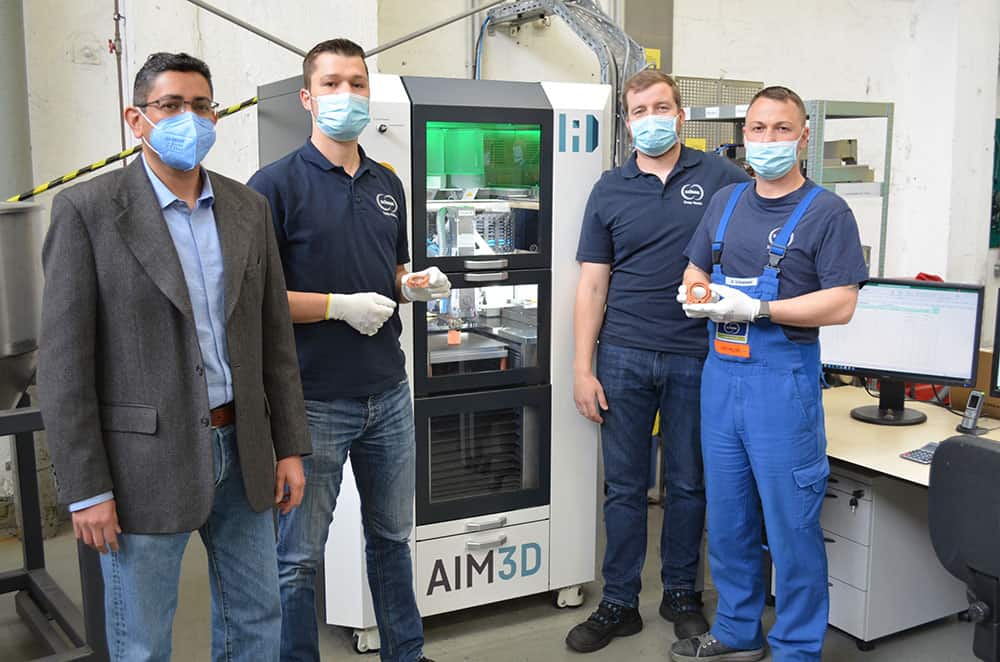
The CEM system ExAM 255 from AIM3D in Thale, Germany – (from left to right) Daniel Alfonso (Global Business Development – Metal Additive Manufacturing), Christian Stertz (Project Manager Plant Engineering), Marcus Trapp (Process Manager at Schunk) and Dennis Grützemann (Operator Plant Engineering) (Image source: Schunk)
The materials specialist company Schunk is now also a service provider for 3D metal printing. Schunk, a supplier of series-production solutions for metal powder pressing and injection moulding as well as other technologies, has expanded its expertise to include 3D metal printing at its facility in Thale, Germany.
Highlights
This expansion of the metal injection moulding process chain in the field of additive manufacturing makes sense with regard to future bionic construction applications and topology optimisation. Component characteristics and cost-effectiveness require different process technologies and manufacturing strategies when it comes to 3D metal printing. In 2020, Schunk expanded its expertise to include the composite extrusion modelling process (CEM) by acquiring an ExAM 255 multi-material 3D printing system from AIM3D. The first results of this development partnership can now be seen, as Christian Stertz, project manager for systems engineering at Schunk explains.
The aim of the cooperation between Schunk and AIM3D covers three strategic approaches:
The focus here is on rapid prototyping and low-volume production, where batches are too small for conventional sintering technology. The creation of copper components using 3D printing is one such development project. Christian Stertz, project manager for systems engineering at Schunk, describes what makes printing with copper so special.
3D component development in copper is of strategic importance to Schunk, as there are only a few suppliers on the market. The conductive material is required for certain components in the electronics industry. However, the range of industries and applications is wide, including applications focusing on thermal management, primarily in mechanical and plant engineering. There are also applications with an emphasis on low-loss energy transmission, such as e-mobility, welding and hardening technology, as well as in the field of energy supply. Pure copper as well as copper alloys are utilised in these applications. According to Christian Stertz, the ExAM 255 system from AIM3D featuring CEM technology enables thermal or electrical conductivity advantages to be retained in 3D printing processes. He sees this as a unique selling point, highlighting better and higher conductivity values on the surface and within the components compared to other additive manufacturing processes. In addition, the CEM process offers material price and resource conservation benefits.
For example, Schunk has developed induction hardeners (inductors) for gear wheels in the automotive sector and for chain wheels on chainsaws. This involves induction hardening of a component through partial surface hardening for the highest mechanical requirements. The physical properties of these copper components are a density of approx. 8.5 g/cm³ (rel. approx. 95-96%) with 75-80% conductivity (% IACS). The density values achieved are comparable to metal injection moulding (MIM) processes. The density of the copper, in particular, affects conductivity as well as mechanical properties, such as hardness or wear resistance. Christian Stertz emphasises the benefits of this AM process compared to conventional manufacturing strategies. The high degree of geometric freedom allows for internal channels or undercuts. In addition, bionic structures that save weight and material while increasing functionality also enable cost savings. As is the case with any AM process, using CEM systems from AIM3D results in savings on machining and tooling costs as it is not a mould-based process. However, the following also applies: the CEM process tends not to be suitable for very simple geometries and for large batches, since well-established series-production processes such as MIM are more advantageous in these cases.
Market trends in the field of 3D metal printing
Christian Stertz, project manager for systems engineering at Schunk, sees strong AM process potential in a very diverse range of market segments:
Source: Company Press Release
Subscribe to AM Chronicle Newsletter to stay connected: https://bit.ly/3fBZ1mP
Follow us on LinkedIn: https://bit.ly/3IjhrFq
Visit for more interesting content on additive manufacturing: https://amchronicle.com/
Researchers have developed a way to consistently produce a special type of stainless steel known…
APF designed to enable superalloy development in direct energy deposition. Nikon has announced the release of…
Schoeller-Bleckmann Oilfield Technology GmbH (SBOT), based in Ternitz, Austria, has completed the first expansion stage…
The companies will work together to develop new standards for the energy industry using cold…
Fortius Metals, a company located in Colorado and specializing in supplying metal wires for additive…
ADNOC Gas has developed one of the energy industry’s largest digital libraries of critical components,…
This website uses cookies.